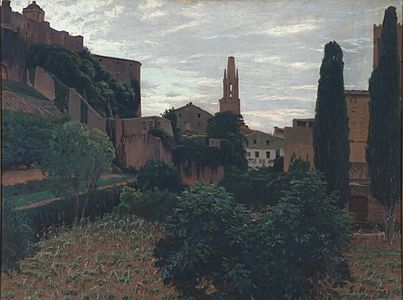Santiago Rusiñol facts for kids
Quick facts for kids
Santiago Rusiñol i Prats
|
|
|---|---|

Rusiñol in 1892
|
|
| Born | 25 February 1861 |
| Died | 13 June 1931 (aged 70) Aranjuez, Spain
|
| Nationality | Spanish |
| Education | Studio of Tomás Moragas |
| Known for | Painting, Poetry, Theater |
| Movement | Modernisme |
| Spouse(s) | Lluïsa Denís |
Santiago Rusiñol i Prats (born February 25, 1861 – died June 13, 1931) was a famous Spanish painter, poet, and playwright. He was also a journalist and a collector. Santiago Rusiñol was a key leader of the modernisme art movement in Catalonia, Spain. He created over a thousand paintings and wrote many books and plays in both Catalan and Spanish.
Contents
A Young Artist's Journey

Santiago Rusiñol was born in Barcelona. His family owned a textile factory. Even though he was supposed to take over the family business, Santiago loved art from a young age. He decided to follow his passion for painting and writing.
In 1886, he married Lluïsa Denís i Reverter. Their daughter, Maria Agustina, was born the next year. Santiago was a restless person. He was not interested in the family business. He wanted to paint and travel the world. So, he gave the factory to his brother Albert. After that, Santiago traveled a lot. He explored Catalonia, Spain, France, and Italy. Traveling became a big part of his life.
Life in Paris and Sitges
In 1888, Santiago started writing for the newspaper La Vanguardia. In 1889, he moved to Paris to study art. He lived there on and off for ten years. During this time, he did not have much contact with his family, but he stayed in touch with his daughter.
In 1893, he set up his art studio in Sitges. This studio is now the Cau Ferrat. Sitges became a very important place for modernisme artists. Santiago and his friends organized special festivals there. These events combined theater, poetry, painting, and music.
Santiago kept writing stories and poems. Some of his novels were even turned into plays. One famous play was L'auca del senyor Esteve, written in 1907. By the early 1900s, he was a well-known painter and writer. He was famous in Barcelona, Spain, and Paris. In 1899, he became very ill. This led him to reconnect with his wife. In 1908, he became an official member of the Paris Salon.
Friends and Recognition
Santiago Rusiñol was part of a famous group of artists. They met at the Els Quatre Gats brewery in Barcelona. Young Pablo Picasso also visited this place. Santiago was very close friends with the painter Ramon Casas and the sculptor Enric Clarasó. They remained friends throughout his life.
In the next two decades, Santiago's fame grew in Barcelona. He even received the Legion of Honour from the French government in 1917. This is a very high award.
Santiago Rusiñol passed away in Aranjuez in 1931. He was later buried in Barcelona.
His Artworks
Santiago Rusiñol learned to paint at the studio of Tomàs Moragas. There, he learned drawing and different techniques like oil and watercolor. He first showed his art in Barcelona in 1879. He worked with the Sala Parés gallery for many years.
He loved to paint natural scenes from Catalonia. He also painted everyday life, showing people doing their daily tasks. His art was often praised by critics.
In 1888, he had his first solo art show. He also showed his work at the Paris Salon. That same year, he took part in the Barcelona World's Fair.
Gallery
-
Portrait of Miquel Utrillo
-
Rouen Street, France
See also
 In Spanish: Santiago Rusiñol para niños
In Spanish: Santiago Rusiñol para niños
- List of Orientalist artists
- Orientalism













